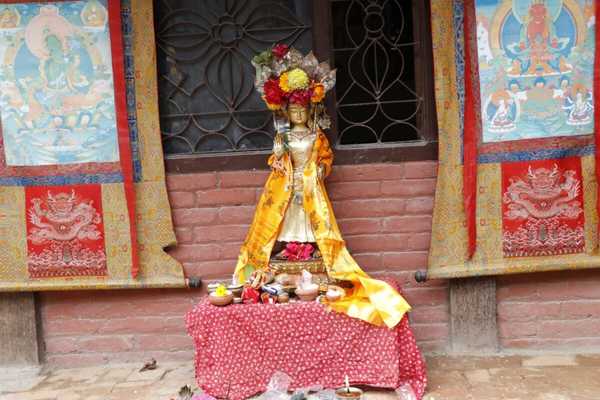Following the Buddha – The Phudyaḥ (Dīpaṅkara) Yātrā of the Pañcadāna Festival in Patan
Curated by Christiane Brosius and Nutan Sharma (2020/21 CE) The Dīpaṅkara Buddha, or ‘Maker of Light’, is said to predate the historical Gautama Buddha, and is often equated with the first Buddha. Pañcadāna (lit. ‘five offerings’) is a festival in which the initiated Śākya and Vajrācārya males have to manifest their monastic status by going from house to house to collect alms from at least seven houses. In the historic city of Patan, this festival is known as Yala (Patan) Pañcadāna. It is celebrated on the 8th lunar day of the bright fortnight of the Śrāvaṇa month according to the lunar calendar; in 2020, that day fell on July 28.
On the day of Pañcadāna, initiated male lay devotees offer alms to the Vajrācārya priests and Śākya householder monks. Of central importance is Phudyaḥ – a approximately 60 cm high gold-plated copper icon of the Dīpaṅkara Buddha. The icon of the deity is carried from house to house, and from monastery to monastery, by the Śākyas of the Ukubahāḥ monastery. When the deity visits the selected places, it is worshipped with gifts (dāna). Offerings are mainly rice grains, wheat grains, salt, fruits, money and the likes.
The Phudyaḥ Yātrā continues from morning until late evening. The icon of Phudyaḥ, usually kept in the Ukubāhāḥ monastery, is cleaned one day before and on the next day, in the morning on the very day of the procession, it is displayed in the northern wing of the monastery with its ornaments and full decorations. At that time, local residents, mainly Śākyas of the locality, come to offer their pūjā and alms to the deity. After that the yātrā begins its traditional route.
The route can be divided into two parts. The first circumambulation with 10 stops starts and ends in Ukubāhāḥ in the morning. Even upon returning to its home monastery, the icon of the deity does not enter the vihāra. It remains outside while participants are allowed to enter the monastery to have their lunch
1. The second circumambulation with 15 stops – from noon to evening – takes a different route
2
1. This part seems to be dedicated to the Guitanakiṃ with whom the Dipaṅkara Buddha accepted the first dāna according to the above-mentioned legend. ↩2. This part seems to be dedicated to the King Sarvānanda of the legend with whom the Dipaṅkara Buddha accepted the second dāna, as this second route of the jātrā goes through the royal palace of Patan.↩ Michaels, Axel. “From Syncretism to Transculturality: The Dīpaṅkara Procession in the Kathmandu Valley.” In South Asian Festivals on the Move, edited by Ute Hüsken and Axel Michaels, 317–42. Wiesbaden: Harrassowitz, 2013..










































